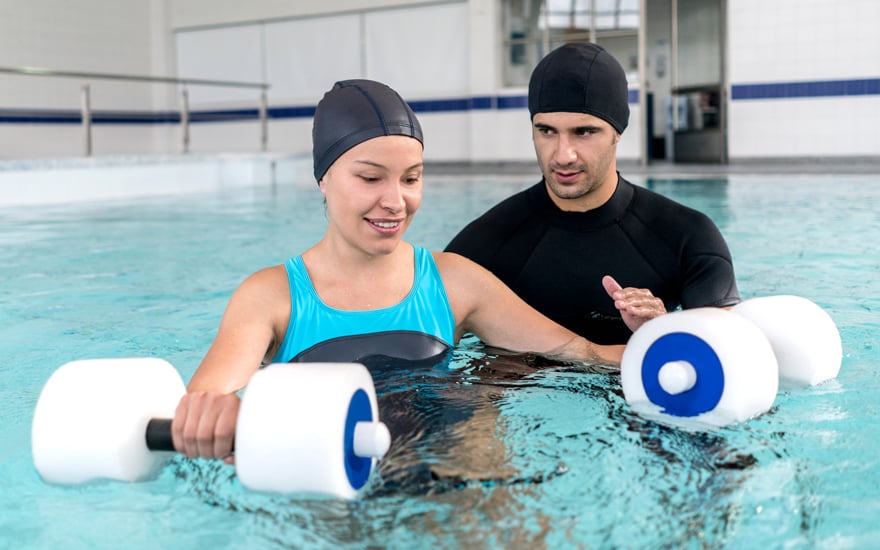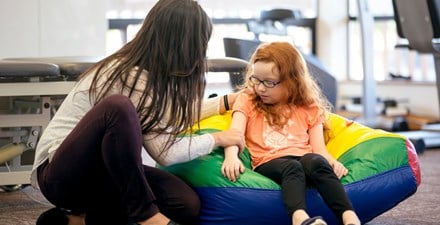Physical Therapy Guide to Fibromyalgia
Fibromyalgia is a chronic condition in which a person experiences widespread chronic pain and fatigue. It is often difficult to diagnose and affects up to 10 million people in the United States. Fibromyalgia usually is diagnosed in adults between the ages of 30 and 50, of whom 75% are women. The symptoms can appear earlier.
Although there is no cure at this time, there are treatments that can help. Your physical therapist can help you:
- Understand and manage your pain.
- Reduce your fatigue.
- Improve your function and quality of life.
Physical therapists are movement experts. They improve quality of life through hands-on care, patient education, and prescribed movement. You can contact a physical therapist directly for an evaluation. To find a physical therapist in your area, visit Find a PT.
What Is Fibromyalgia?
Fibromyalgia is a complex, chronic pain condition; the cause is unknown. It is thought to be related to genetics, traumatic life events, inflammation, and emotional stress. Fibromyalgia may develop on its own over time. It also can develop after trauma, joint degeneration, or stressful times. People with conditions, such as rheumatoid arthritis, systemic lupus, or ankylosing spondylitis, are more likely to develop it.
Physical therapy is a safe alternative to prescribed pain medication for long-term pain management. Learn more at our Safe Pain Management page.
Signs and Symptoms
Fibromyalgia isn't just one condition. Instead, it is a complex syndrome involving many signs and symptoms. You may experience:
- Widespread pain, often a dull ache, on both sides of the body above and below the waist.
- Spots on your head, neck, chest, shoulders, elbows, hips, or knees that are tender to a firm touch. These "tender points" may move around or come and go.
- Muscle stiffness, especially in the morning.
- Fatigue.
- Trouble sleeping and waking unrefreshed.
- Headache.
- Thinking and memory problems.
- Depression.
- Anxiety.
- Pain or cramps in the abdomen or pelvis.
- Irritable bowel syndrome.
- Irritable bladder syndrome.
- Numbness or tingling.
Often, stress can make your symptoms worse.
How Is It Diagnosed?
There are no blood tests, imaging scans, or muscle biopsies that can be used to diagnose fibromyalgia. This means that you will need to work closely with your health care providers to get an accurate diagnosis. Many conditions can cause pain and fatigue, so a thorough medical exam is important. Before diagnosing fibromyalgia, your health care providers will need to rule out other problems such as:
- Rheumatic conditions that cause inflammation or infectious diseases.
- Lyme disease.
- Hypothyroidism (underactive thyroid).
- Metabolic disease, such as Type 2 diabetes and metabolic syndrome.
- Medication side effects.
The diagnosis is based on key symptoms, including:
- Extreme fatigue.
- Generalized pain.
- Trouble sleeping.
- Sensitivity to cold, light, or noise.
- Memory and/or concentration problems.
Your physical therapist can identify fibromyalgia while performing a routine exam. They will take your health history and pay close attention to the pattern of your symptoms. Your physical therapist may refer you to a doctor specializing in arthritis (rheumatologist). This physician can provide medical care that includes prescribing arthritis medicines.
How Can a Physical Therapist Help?
Living with fibromyalgia can be challenging. Your pain and other symptoms might take different forms from day to day. Also, your physical fitness may decline if you avoid activity because of pain.
A vast amount of research supports a multipronged approach to help improve fibromyalgia that includes:
- Education.
- Exercise.
- Medication.
- Psychotherapy.
Often, fear of pain keeps people from starting an exercise program. Your physical therapist will teach you how to interpret pain signals. They will help you through a customized exercise program and teach you ways to manage and decrease your symptoms.
Patient Education
Research shows that people who understand their health condition:
- Have more confidence.
- Can cope better.
- Are more likely to get "back in the swing" of things.
Your physical therapist can explain how your condition affects how your body perceives and responds to pain. They also can teach you how to start taking control of your pain rather than the pain controlling you. The evidence suggests that knowledge is power when it comes to managing pain. Several books, such as Why Do I Hurt?, have helped people in pain.
Your physical therapist also can provide information on local support groups and exercise and self-help programs.
Personalized Exercise Program
Your physical therapist will design an exercise program tailored to your specific needs. Regular, moderate exercise is an essential part of managing fibromyalgia. Reducing body mass index can actually reduce the risk of developing it.
Research shows that the following activities can decrease pain and improve function, general health, and sleep in people with fibromyalgia:
- Aerobic conditioning.
- Aquatic exercise.
- Stretching.
- Strengthening exercise.
- Yoga.
- Tai chi.
- Deep breathing.
- Recreational activities.
- Manual therapy.
Your physical therapist will design an exercise program that's right for you. To ensure your success, they will show you how to:
- Start slowly.
- Pace yourself.
- Set realistic goals for exercise and physical activity.
- Modify your program in times of stress.
Your physical therapist can help you improve your fitness and quality of life by developing an aerobic exercise program for your specific needs. This program will be designed to train your heart, lungs, and muscles. Exercises may include:
- Walking briskly (at a pace where you can talk, but you must take deep breaths).
- Bicycling.
- Swimming.
- Stair-climbing or using an elliptical machine.
Your physical therapist will work with you to gradually increase your overall activity level and exercise tolerance. Depending on your symptoms and abilities, they may start you with exercises you do for short periods (10 minutes or less). They will gradually help you build up your tolerance for longer exercise. Even short, 10-minute exercise sessions two or three times daily can improve your strength and endurance. If you have milder symptoms, your physical therapist might focus on improving your muscle strength or cardiovascular fitness. They also may recommend aquatic exercise. Pool exercises can help reduce stiffness and pain while you exercise.
Even if you start out slowly, you are likely to have more pain as a result of increasing your activity. Your physical therapist will prepare you by teaching you pain relief techniques you can use at home. These may include activities such as relaxation techniques and stretching exercises.
Some people also have other conditions in addition to fibromyalgia. Conditions like tendinitis, arthritis, or heart disease can make exercise more challenging. Your physical therapist is uniquely trained to personalize treatment for these conditions. They will consider how other conditions can affect your symptoms and exercise ability.
Your doctor may prescribe medicines that target the brain chemicals responsible for how your body deals with pain. Physical therapists also account for your medications and their potential effects on your movement and exercise ability.
Improving Your Range of Motion
Manual therapy. Your physical therapist may gently move your joints with manual (hands-on) therapy. Manual therapy can help to improve your range of motion. These techniques are combined with exercise, stretching, and movements that you control.
Reducing Your Pain
To reduce your pain, your physical therapist may select from or use several treatments, including:
Manual therapy. Your physical therapist can help to relieve pain and make your muscles more flexible. They may press on specific areas of your muscle, then stretch or contract them. They also may use other hands-on techniques to help relieve pain in your muscles and the tissues around them.
Dry needling. Some physical therapists use dry needling to relieve your pain. The treatment involves inserting very fine needles into the painful areas of the muscle.
Gentle massage. Your physical therapist may use massage therapy to increase blood flow and promote muscle relaxation. This can help decrease muscle pain and stiffness and break up scar tissue.
Electrical stimulation. Depending on the severity of your pain, your physical therapist might use electrical stimulation to reduce pain. Some people find that portable electrical stimulation devices help them manage severe pain. Your physical therapist will work with you to see if this type of treatment makes sense for you.
Applying Special Techniques
Research indicates that the best results will likely come from combining various treatments for fibromyalgia. The right medicines, exercise, and "mind-body techniques" can work together to help you manage your symptoms.
Meditation and cognitive behavioral therapy can change your responses to pain and promote relaxation. Physical therapists also know how to recognize behaviors that may delay recovery of function. They often refer patients to other health care providers who can help them overcome these barriers.
Biofeedback. Your physical therapist might use biofeedback to help you control muscle tension and decrease pain. Biofeedback uses a device that provides you with information about the amount of tension in your muscles. They will place electrodes on your skin with a soft gel. The electrodes record muscle tension while your physical therapist explains in real time how to relieve that tension.
Your physical therapist also can provide tips for sleeping and waking to allow for good restorative sleep. They may discourage you from sleeping during the day, which can throw off your sleep cycle.
Can This Injury or Condition Be Prevented?
Unfortunately, the mechanisms behind fibromyalgia are not entirely understood. Because of this, there is no way to predict or prevent its onset. However, identifying the signs and symptoms and working with your medical providers to begin early management may enhance your long-term outcomes.
What Kind of Physical Therapist Do I Need?
All physical therapists are prepared through education and experience to treat people who have fibromyalgia. You may want to consider:
- A physical therapist who is experienced in treating people with fibromyalgia or musculoskeletal problems.
- A physical therapist who is a board-certified clinical specialist or who completed a residency or fellowship in orthopedic physical therapy. This physical therapist has advanced knowledge, experience, and skills that may apply to your condition.
You can find physical therapists with these and other credentials by using Find a PT, the online tool built by the American Physical Therapy Association to help you search for physical therapists with specific clinical expertise in your geographic area.
General tips when you're looking for a physical therapist:
- Get recommendations from family, friends, or other health care providers.
- When you contact a physical therapy clinic for an appointment, ask about the physical therapist's experience helping people with fibromyalgia.
- Be prepared to describe your symptoms in as much detail as possible and say what makes your symptoms worse.
Additional Resources
The American Physical Therapy Association believes that consumers should have access to information that can help:
- Inform their health care decisions.
- Prepare them for their visit with a health care provider.
The following resources offer some of the best scientific evidence related to physical therapy treatment for fibromyalgia. They report recent research and provide information on the standards of practice in the United States and internationally. They link to a PubMed* abstract (which may offer free access to the full text) or other resources. You can read them to learn more or bring a copy to your health care provider.
Giorgi V, Sirotti S, Romano ME, et al. Fibromyalgia: one year in review 2022. Clin Exp Rheumatol. 2022;40(6):1065–1072. Article Summary in PubMed.
Sarzi-Puttini P, Giorgi V, Marotto D, et al. Fibromyalgia: an update on clinical characteristics, aetiopathogenesis, and treatment. Nat Rev Rheumatol. 2020;16(11):645–660. Article Summary in PubMed.
Arnold LM, Bennett RM, Crofford LJ, et al. AAPT diagnostic criteria for fibromyalgia. J Pain. 2019;20(6):611–628. Article Summary in PubMed.
Bidonde J, Busch AJ, Schachter CL, et al. Aerobic exercise training for adults with fibromyalgia. Cochrane Database Syst Rev. 2017;6(6):CD012700. Article Summary in PubMed.
Macfarlane GJ, Kronisch C, Dean LE, et al. EULAR revised recommendations for the management of fibromyalgia. Ann Rheum Dis. 2017;76(2):318–328. Article Summary in PubMed.
Sosa-Reina MD, Nunez-Nagy S, Gallego-Izquierdo T, et al. Effectiveness of therapeutic exercise in fibromyalgia syndrome: a systematic review and meta-analysis of randomized clinical trials. Biomed Res Int. 2017;2017:2356346. Article Summary in PubMed.
Busch AJ, Webber SC, Richards RS, et al. Resistance exercise training for fibromyalgia. Cochrane Database Syst Rev. 2013;(12):CD010884. Article Summary in PubMed.
Expert Review:
Jul 31, 2024
Revised:
Nov 1, 2024
Content Type: Guide
Fibromyalgia
PT, MS
PT, DPT
PT, DPT, board-certified clinical specialist in orthopaedic physical therapy
PT, DPT, MPH
Laura Thornton
PT, DPT, board-certified clinical specialist in orthopaedic physical therapy, fellow of the American Academy of Orthopaedic Manual Physical Therapists
You Might Also Like...
Article
Women's Health Physical TherapyJul 9, 2024
Women's health physical therapy focuses on the unique wellness and rehabilitation needs of women throughout their lifespan, and treatment for the many
Health Tips
Amplified Pain Syndromes in Children: What You Should KnowMay 6, 2022
Amplified musculoskeletal pain syndrome is a chronic condition in which a person feels more intense pain than expected. Children with AMPS can have a spectrum
Health Tips
Physical Therapy vs Opioids: When to Choose Physical Therapy for Pain ManagementMar 16, 2016
Prescribed opioids come with great risks, and they are not the only way to manage pain. The Centers for Disease Control and Prevention recommends nonopioid



